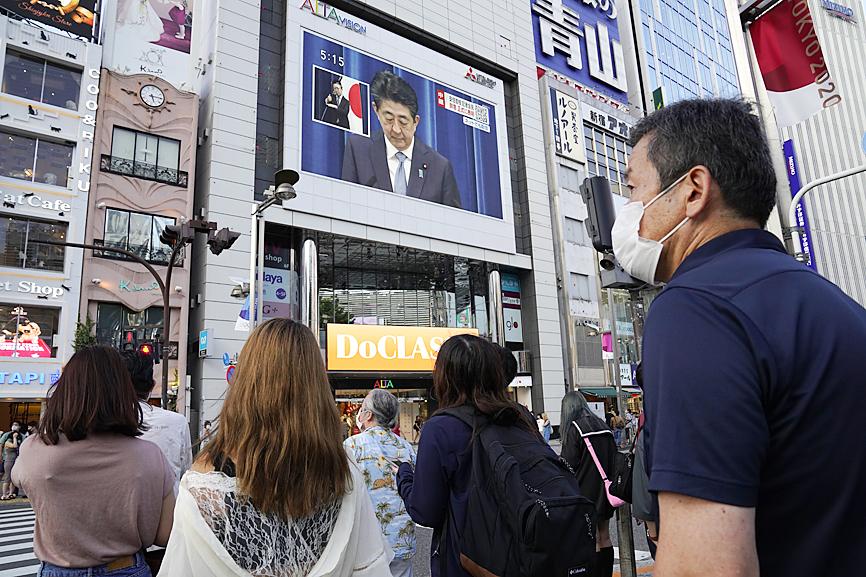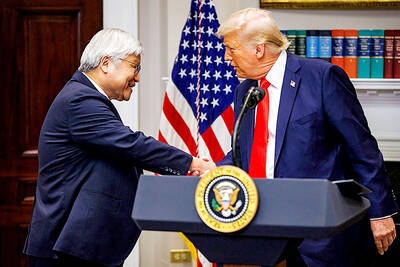The race to succeed Japanese Prime Minister Shinzo Abe started informally yesterday, with several contenders announcing their plans to stand, a day after Japan’s longest-serving leader announced his resignation.
Abe said he was experiencing a recurrence of ulcerative colitis, the condition that forced him to cut short his first term in office, but that he would stay on until his successor is decided.
Exactly how the process would unfold was still unclear, with local media reporting that several options were being considered.

Photo: EPA-EFE
Abe’s ruling Liberal Democratic Party (LDP) could opt for a more traditional leadership election, involving lawmakers but also members of the party nationwide.
The LDP would choose Abe’s successor on about Sept. 15, Kyodo news agency reported.
However, the urgency of the situation, as well as the constraints imposed by the COVID-19 pandemic, could see the party instead opt to poll only its lawmakers and regional representatives — a faster process.
A few would-be candidates have thrown their hats into the ring, including party policy chief Fumio Kishida, a mild-mannered former minister of foreign affairs considered Abe’s personal choice for successor, and former minister of defense Shigeru Ishiba, who is seen as more popular with voters, but commands less party support than some other candidates.
Japanese Minister of Finance Taro Aso, himself a former prime minister and long considered a likely successor to Abe, has announced that he would not stand.
Other possible candidates include powerful Japanese Chief Cabinet Secretary Yoshihide Suga, viewed by many as a frontrunner, and Japanese Minister of Defense Taro Kono, a social-media-savvy former foreign minister who is seen as something of a long shot.
One woman is among those expected to stand so far: Seiko Noda, a former Cabinet minister whose chances are thought to be slim.
Whoever comes out on top, little major shift in policy is expected, analysts have said.
“Key policies — diplomacy and economic measures — won’t be changed drastically,” Shinichi Nishikawa, a professor of political science at Meiji University in Tokyo, told reporters.
“His successor could be a caretaker,” Nishikawa added, given that the LDP is to hold another leadership election in September next year, with general elections likely the following month.
Additional reporting by Reuters

SECURITY: The purpose for giving Hong Kong and Macau residents more lenient paths to permanent residency no longer applies due to China’s policies, a source said The government is considering removing an optional path to citizenship for residents from Hong Kong and Macau, and lengthening the terms for permanent residence eligibility, a source said yesterday. In a bid to prevent the Chinese Communist Party (CCP) from infiltrating Taiwan through immigration from Hong Kong and Macau, the government could amend immigration laws for residents of the territories who currently receive preferential treatment, an official familiar with the matter speaking on condition of anonymity said. The move was part of “national security-related legislative reform,” they added. Under the amendments, arrivals from the Chinese territories would have to reside in Taiwan for

CRITICAL MOVE: TSMC’s plan to invest another US$100 billion in US chipmaking would boost Taiwan’s competitive edge in the global market, the premier said The government would ensure that the most advanced chipmaking technology stays in Taiwan while assisting Taiwan Semiconductor Manufacturing Co (TSMC, 台積電) in investing overseas, the Presidential Office said yesterday. The statement follows a joint announcement by the world’s largest contract chipmaker and US President Donald Trump on Monday that TSMC would invest an additional US$100 billion over the next four years to expand its semiconductor manufacturing operations in the US, which would include construction of three new chip fabrication plants, two advanced packaging facilities, and a research and development center. The government knew about the deal in advance and would assist, Presidential

‘DANGEROUS GAME’: Legislative Yuan budget cuts have already become a point of discussion for Democrats and Republicans in Washington, Elbridge Colby said Taiwan’s fall to China “would be a disaster for American interests” and Taipei must raise defense spending to deter Beijing, US President Donald Trump’s pick to lead Pentagon policy, Elbridge Colby, said on Tuesday during his US Senate confirmation hearing. The nominee for US undersecretary of defense for policy told the Armed Services Committee that Washington needs to motivate Taiwan to avoid a conflict with China and that he is “profoundly disturbed” about its perceived reluctance to raise defense spending closer to 10 percent of GDP. Colby, a China hawk who also served in the Pentagon in Trump’s first team,

The arrival of a cold front tomorrow could plunge temperatures into the mid-teens, the Central Weather Administration (CWA) said. Temperatures yesterday rose to 28°C to 30°C in northern and eastern Taiwan, and 32°C to 33°C in central and southern Taiwan, CWA data showed. Similar but mostly cloudy weather is expected today, the CWA said. However, the arrival of a cold air mass tomorrow would cause a rapid drop in temperatures to 15°C cooler than the previous day’s highs. The cold front, which is expected to last through the weekend, would bring steady rainfall tomorrow, along with multiple waves of showers